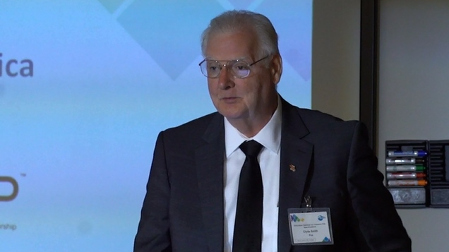Common File Specifications—Now It’s North America’s Turn
The 2011 tsunami that ravaged Japan was horrific. The loss of 16,000 lives was tragic and the Fukushima nuclear power plant destruction was devastating. This tragedy even had a profound impact on the television business. While the loss of Sony’s videotape manufacturing facility paled by comparison with other aspects of the disaster, it disrupted the worldwide television industry’s supply of its essential resource. This tragedy accelerated television’s move from tape to video file recording.
Despite numerous advantages of video files compared with videotape, three major U.K. broadcasters, BBC, ITV and Channel 4, were first to recognize and address a major void. Video files must be supplemented by metadata that would be associated with the video, stored with and traveling with the video, providing the data necessary for downstream equipment to meaningfully handle the video. The British broadcasters saw that the great diversity of emerging metadata formats was problematic, costly and inefficient. In 2011 these broadcasters formed the DPP, the Digital Production Partnership, for the purpose of developing a common video file format specification for the U.K. Driven by the videotape shortage resulting from Japan’s tsunami, they established a definitive date by which all program delivery to these U.K. broadcasters (a group which had grown) must conform to the new DPP video file format spec.
ADOPTION OF EXISTING TECHNICAL STANDARDS

Clyde Smith addresses delegates at the Toronto educational seminar.
In 2015, NABA’s Technical Committee (TC) saw the wisdom in the U.K. work and, with the concurrence of NABA’s Board of Directors, established a sub-committee to develop a common video file format for North America. Fox’s Clyde Smith chaired this group from the outset. The subcommittee was comprised of representatives: most national broadcasters, numerous technology companies and program production companies. The group’s approach was to not reinvent the wheel, but rather to evaluate and adopt existing technical standards upon which the NABA spec would be based. The committee also recognized the value in commonality with the results of the U.K.’s DPP work. The NABA committee began with the premise that the technical spec, while providing the efficiencies of standardization, would and could maintain the flexibility needed to meet the competitive business needs and strategies that differentiate industry participants.
The NABA- DPP technical specifications were created in conjunction with the Digital Production Partnership in response to requests from the major North American broadcasters to address interoperability issues in program delivery as files. These documents form a Standards-Based approach to specifying the technical requirements for the delivery of programming as files, delivered for on-air operations. The Standards-Based fulfillment of these technical requirements for file-based program interoperability is provided by citing a series of Standards, and then addressing the issues that frequently cause interoperability problems by specifically citing the appropriate modes and options supported by these standards, which are necessary to insure interoperability for broadcasters.
There are two Air Ready Master technical specifications; while they both utilize MXF, one was created for MPEG 2 codec-based files and another for AVC codec-based files. After one year of effort, the result was the NABA- DPP Common Video File Format Specification for Air Ready Masters. The version for broadcast delivery was completed in 2016 and the versions for Library Masters, in HD and UHD, and UHD Air Ready Masters, will be completed this year.
The professional video industry's #1 source for news, trends and product and tech information. Sign up below.
EDUCATING THE INDUSTRY
NABA has been encouraging broadcasters to adopt and plan for the implementation of the Common File Format and implement it at timing based upon each company’s individual technology replacement cycle. As of this writing, the NABA-DPP Spec has been adopted by CBS, Fox, PBS and CBC/Radio-Canada, as well as the U.K. broadcasters. Several others are expected to announce their plans in the coming months.

In late 2016, NABA recognized the need to educate a broader group of industry players—broadcasters, technology suppliers and the production community. A brochure was prepared for distribution and presentations were made at industry meetings like HPA and NAB. A digital copy of the brochure is available on the NABA website. Seminars were held throughout May in NY, LA, Atlanta and Toronto, where all in the television ecosystem were able to learn about the new spec and the benefits that will accrue to those who adopt it. NABA is continuing its effort to educate the industry so that production companies, technical services organizations and technology vendors can be prepared to meet broadcasters’ needs, so that all in the ecosystem can reap the benefits.
A recording of the seminar will be available on the NABA website soon as well.
The Common File Specification for North America is designed to simplify video file workflow by eliminating incompatibility, ambiguity and deviation. By providing clarity, compliance and commonality, the NABA-DPP Spec provides economic, workflow and staffing benefits by reducing the costs of operations, technology, quality control and rejections while increasing the volume needed to support today’s multiplatform workflows.
The process to develop, adopt and implement NABA’s Common File Specification for North America is an example of the benefit of broadcasters, producers and technology suppliers working together to solve common problems in a way that is helpful to all.
For more information on the NABA-DPP spec, visit here.
Reprinted by permission from NABA.
See also
DPP Releases Updated Program Delivery Specs
U.K. Broadcasters Just Say 'No' to Videotape
DPP, NABA Define Supplier Cybersecurity Requirements
Nine TV Groups Agree on Air-Ready File Delivery Specs
